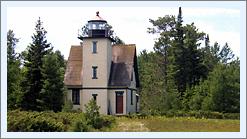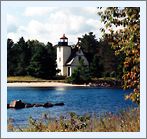|
Historical Information

As a result of increasing industrialization around Lac LaBelle, a cut
was created from the Big Lake into Lac LaBelle to allow access to the
big ships that plied the Great Lakes.
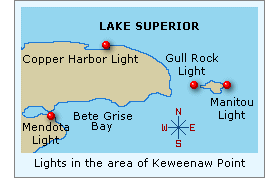 As a result, the construction of the Mendota Light was first considered by the US Congress in 1867, when an appropriation of $14,000 for the construction of a light station was approved on March 2, with the terms of the contract called for construction of the structure to begin in 1869, with final completion no later than November 1870. As a result, the construction of the Mendota Light was first considered by the US Congress in 1867, when an appropriation of $14,000 for the construction of a light station was approved on March 2, with the terms of the contract called for construction of the structure to begin in 1869, with final completion no later than November 1870.
Later that year, it was realized that declining industrial development in the area would no longer support the planned deepening of the cut into Lac Labelle, and it was deemed that the light would serve no purpose.
Decommission was ordered, and instructions to dismantle the structure were issued to the crew of the steamer "Haze," with all
equipment to be returned to USLHS headquarters in St. Joseph for eventual reuse. (The lens and mechanics were later reused in the Marquette Breakwater light.)
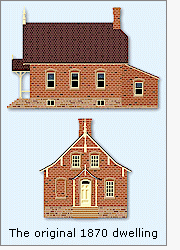 Thus, the Mendota light station was decommissioned before it saw real service, and the structure sat idle and blinded for the following twenty two years. Thus, the Mendota light station was decommissioned before it saw real service, and the structure sat idle and blinded for the following twenty two years.
In the following years, Great Lakes shipping increased dramatically, and many ships rounding the
Keweenaw began using Bete Grise Bay as a shelter during rough seas. In 1892 it was determined that a reactivation of the Mendota light, along with relocation closer to the bay would make bay entry a far safer proposition for such ships seeking shelter.
Authorization for reactivation was issued on February 15, 1893, and $7,500 was appropriated to cover the expenses.
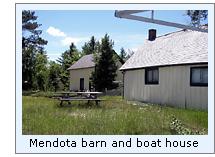 In 1894, in it's annual report, the Lighthouse Board reported that "The brick house of the discontinued station had been ruined by the storms of the past winter, and thus the existing building was unusable, and increased the amount of the appropriation to $10,000 to cover the cost of
constructing a new station. In 1894, in it's annual report, the Lighthouse Board reported that "The brick house of the discontinued station had been ruined by the storms of the past winter, and thus the existing building was unusable, and increased the amount of the appropriation to $10,000 to cover the cost of
constructing a new station.
Materials were delivered by the USLHS tender
"AMARANTH" in September, 1895, and the cook house and quarters for the workers were erected. The old house was torn down, and all the material that could be reused in the new structure were cleaned and piled. The foundation of the tower and dwelling was completed and the brick work laid up to the top of the first floor joists. The boathouse was almost completed and the fence posts were all set. During October the oil house and the outhouse was completed. The dwelling and all outbuildings and sidewalks were completed in November. On November 30, 1895, a
white Fourth Order Fresnel lens, varied by a flash every 45 seconds, was installed.
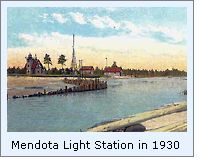 On October 31 1896, the flashing light sequence was altered to a fixed white
light, and the Mendota Light was thus reborn! On October 31 1896, the flashing light sequence was altered to a fixed white
light, and the Mendota Light was thus reborn!
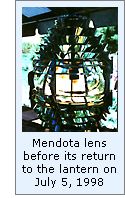 In 1933 the lighthouse became unattended, and was decommissioned in
1956. The property was sold at auction to Paddy Jaaskelainen. Paddy
cared for Mendota until his death in 1996. The family searched for
someone to carry on the tradition and preserve Mendota for future
generations. That someone turned out to be Gary Kohs, owner of Fine Art
Models in Birmingham Michigan, who purchased the
lighthouse, and remains its' current owner. In 1933 the lighthouse became unattended, and was decommissioned in
1956. The property was sold at auction to Paddy Jaaskelainen. Paddy
cared for Mendota until his death in 1996. The family searched for
someone to carry on the tradition and preserve Mendota for future
generations. That someone turned out to be Gary Kohs, owner of Fine Art
Models in Birmingham Michigan, who purchased the
lighthouse, and remains its' current owner.
Driven to put as much love and care
into the lighthouse as he does into his companies incredible scale
models, Gary began a complete restoration of the building, and dreamed of some day
reactivating the light. Fortunate to locate and restore Mendota's Fourth
Order Fresnel Lens, on July 5, 1998 at exactly 9:45 p.m. in front of
approximately 3,500 onlookers, he threw the switch, and once again
Mendota returned to the U.S. Coast Guard Charts as a working lighthouse
sending its white light almost fourteen miles into Lake Superior every
twenty seconds.
Thus, the Mendota Light experienced its' second rebirth.

Keepers of
this Light

Click here
to see a complete listing of all Mendota Light keepers compiled by
Phyllis L. Tag of Great Lakes Lighthouse Research.

Finding this Light

From the West, take US 41 East out of Delaware. Turn South on the road to approximately
five miles to Lac LaBelle. Turn left in Lac LaBelle, and continue for
another five miles to Bete Grise. The road ends at the Mendota Ship
Canal, and there are parking spots beneath the pine trees. Take the
short walk to the the Ship Canal. You will see the station boathouse
across the Canal, and the Mendota Light itself a little to the East.

Reference Sources

Inventory of Historic Light Stations, National Parks Service,
1994.
Annual reports of the Lighthouse Board, various, 1868 - 1909
10 Lights - The Lighthouses of Keweenaw Peninsula. Keweenaw
Historical Society.
Mendota Lighthouse website,
Gary Kohs
Personal visit to Mendota on 09/08/1999
Photographs from author's personal
collection.
Michigan Lighthouses, Penrose, 1992
Keeper listings for this light appear
courtesy of Great
Lakes Lighthouse Research
|
